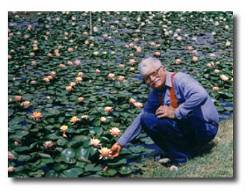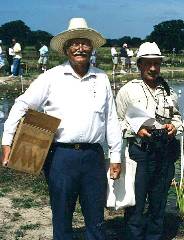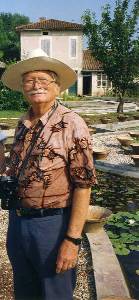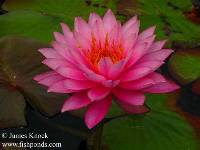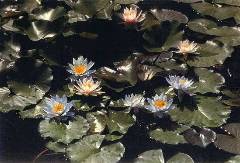NOTE: In the summer of 2001, I was asked to write an article on water lily hybridization pioneer Dr. Kirk Strawn. Helen Nash was going to do a series of articles in her magazine, Helen Nash's Pond & Garden, about the living legends of water lily hybridization. I was asked to do the feature on Kirk. The schedule was that the articles would be in her November/December 2001 issue.
During August of 2001, I went to College Station, Texas, and had the pleasure of visiting with Kirk and Charlene Strawn in the office of Strawn Water Gardens. Previously, I had talked with Charlene a couple of times on the telephone. She was gracious enough to send me some previously printed articles about Kirk, along with some exciting pictures, to help put this article together.
Sadly, a few weeks after the interview, the horrifying events of 9-11 occurred. As a result of tightening economics, Helen's magazine was unfortunately not able to survive. One of the most prolific writers in the water gardening world had to put down her pen. Kit Knotts asked me to go ahead and complete my project for inclusion on Victoria-Adventure. With great excitement, I went ahead and finally finished it.
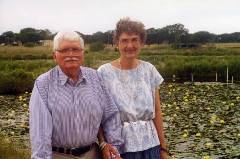 Kirk and Charlene Strawn in 2001 Photo by Duane Eaton |
A True Pioneer Among Water Lily Hybridizers |
|
Dr. Kirk Strawn is, without question, one of the premier hybridizers of hardy water lilies of all time. His introductions have established a new benchmark for color, shape and performance that will be difficult to surpass.
Though Kirk is a Florida native, most of Kirk's professional
career was spent in Texas and Arkansas. Charlene is a Texan,
raised in Dallas. In college, Kirk was headed to the world of
medicine. He was finishing pre-med school and had been accepted
into medical school. It was at that juncture that he decided
to pursue biology instead of medicine, and joined the Navy SeaBees
during World War II. He had been an entomology major at the University
of Florida when he left school for the military. Following his
discharge from the Navy, Kirk and Charlene got married and both
finished their studies at the University of Florida.
While Kirk taught at the University of Arkansas in the early 1970's, the Strawns lived in Fayetteville. Charlene decided that she wanted to grow water lilies, and had two whiskey barrel water gardens in their front yard. From that humble beginning, the legend began.
When the Strawns moved back to College Station in the mid-1970's,
Charlene decided that she wanted to get serious about water gardens.
She had a pond dug in their new backyard. The soil consistency
in College Station was perfect for natural ponds, and Kirk began
to get interested in his wife's favorite hobby. Helping decide
what plants to put in her new pond, he realized that the natural
soil was the ideal medium for water lilies. He quickly became
hooked himself, as one pond after another appeared in their yard.
Pollination by insects very rarely results in a significant plant, but Kirk had this very thing happen to him. One lily defied the odds and he thought it was good enough to keep. Thus, N. Charlene Strawn came onto the market! This was the first plant that he introduced. It is very appropriate, since it was Charlene who got him involved with this hobby in the first place.
At this point, Kirk started hybridizing water lilies in earnest. He also hybridized Louisiana Irises. When he retired from Texas A&M University in 1991, he worked full time with Strawn Water Gardens. He became a worldwide supplier of excellent water lilies, many of which he created. He hybridized more than 50 named water lilies and the same number of Louisiana Irises. Strawn Water Gardens carried over 100 water lily varieties, over 70 Louisiana Iris varieties, and numerous other bog plants.
I asked Kirk what his favorite water lilies are. I gave him my note pad and asked if he could write them down, and his list is as follows, in order:
I also asked him what, in his opinion, were some major events in the history of water gardening. His list included the following:
More people with home gardens
More sellers of water lilies
Introductions of more water lily varieties
Understanding that Latour-Marliac released only infertile plants
Advent of flexible liners
He was a Founding Member of the International Waterlily Society, today the International Waterlily and Water Gardening Society. In 1991, the IWLS recognized Kirk's contributions to the world of water lilies by inducting him in their Hall of Fame. In 1993, when the IWLS had their Symposium in Houston, the Post-Symposium group made a trip to College Station to visit Strawn Water Gardens. Charles Thomas provides this firsthand account that illustrates Kirk's sense of humor:
When Kirk Strawn first became interested in water lilies, there were around 70 named hardy lilies available. Today, there are many, many more, and among the finest of these are the Strawn cultivars. He has expanded our knowledge of hybridization but others who follow in his footsteps will be hard pressed to emulate his success.
SOURCES: Texas Gardener (May/June 1987), The Garden (April 1993), Water Gardening Magazine (May/June 1996), Country Life (May 1996), The Advocate (February 2001), telephone conversations with Charlene Strawn (June/July 2001),.interview with Dr. Kirk & Charlene Strawn (August 2001), interview with John Loggins of Lone Star Aquatics (July 2005), reviewed by Bob Strawn (October 2005).
by Kirk Strawn, PhD
